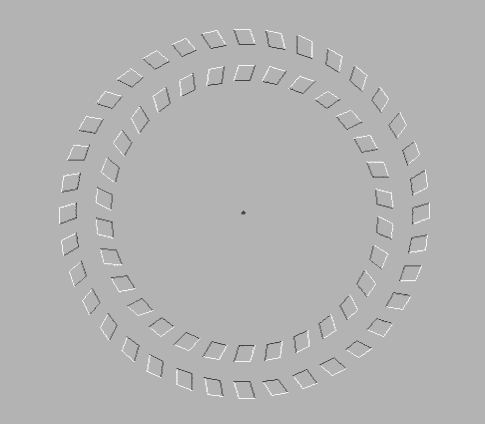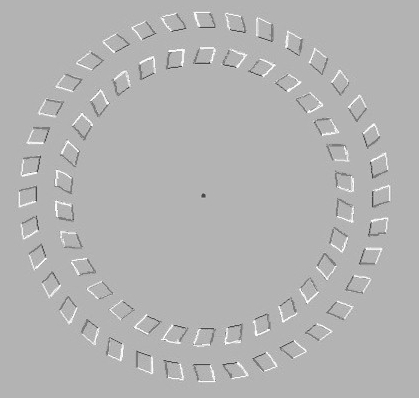
Wheels Illusion

Figure 1
To see the illusion in Figure 1, look at the black dot in the center of the image and move your head towards and away from the screen. You will experience a rotational movement of the inner ring -- clockwise as you move away and counter clockwise otherwise.
When you move your head to and from the pattern, every point on the image moves on a straight line through the image center. For a motion towards the pattern, the actual flow vectors are moving radially from the image center outwards, otherwise they are moving inwards.
The normal flow vectors are perpendicular to the edges of the parallelograms as shown below.

Figure 2
Since the boxes are tilted in different ways in the inner and outer ring, there are different normal flow vectors and as a result, different optical flow estimates (because of different biases) in the two rings. The difference is tangential to the circles and thus experienced as rotation.
The next figure illustrates the flow estimation.

Figure 3
Actually, the estimation is somewhat more elaborate. The vision system not only computes normal flow and flow on the basis of the raw image. But it also smoothes, or blurs, the image and computes normal flow and flow from the blurred image. We say the vision system computes flow at different levels of resolution. The final estimate is an average of the flow estimates at the individual resolutions.
For the pattern here the flow vectors at different resolutions are in the same orientation, thus there will be no difference whether the system used multiple resolutions or not. One can, however modify the pattern by changing the black and white in the edges, thus creating bias in one direction at high resolution and bias in the other direction at low resolution, and this way reducing the illusion as shown below.

Figure 4
Based on the understanding of how the illusion works, we can increase and decrease the effect by changing the texture. For example by inserting small diagonals in the boxes, we make the normal flow distribution in the inner and outer ring about the same. This greatly reduces the illusion.

Figure 5